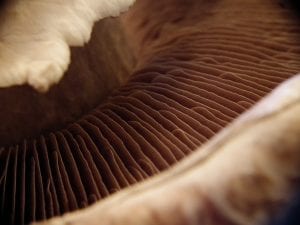
Portobello mushrooms are a biomass-derived carbon anode material tested by University of California, Riverside researchers. (Source: Flickr)
As portable electronic devices evolve, the issue of developing a more economical and environmentally-conscious energy storage device has become pressing. According to researchers from the University of California, Riverside, a solution exists in an improbable candidate: portobello mushrooms.
Most portable electronic devices, such as laptops, cellphones, and tablets, derive power from lithium ion batteries, which consist of a lithium oxide cathode, a lithium ion electrolyte, and a carbon-based anode such as graphite (1). The battery produces a voltage via the oxidation and reduction of lithium ions that transfer electrons through the electrolyte between the cathode and anode to power devices. Although lithium ion batteries are highly efficient and easy to make, their capacity deteriorates with repeated use, as their electrodes become damaged as lithium precipitates (2). Furthermore, the creation of lithium ion batteries leaves a large environmental footprint because it involves the washing and soaking of graphite anodes in strong acids and bases (2).
Campbell et al. from the University of California, Riverside have successfully tested tissue from the caps of portobello mushrooms as a more cost-effective, efficient, and environmentally-friendly alternative to conventional graphite anodes in lithium ion batteries. Among other biomass-derived anodes, portobello mushroom tissues have proven to be the most successful. Their performance is on par with that of the graphite-based industry-standard anodes, and their storage capacity increases with use, which may be leveraged to improve the battery performanceIndianapolis (2, 3).
According to a paper published in September by Campbell et al., samples of skin from the caps of portobello mushrooms were treated with cycles of pyrolysis—baking samples at high temperatures to cause partial oxidation of samples—at either 700, 900, or 1,100 degrees Celsius (2). Subsequently, the samples were incorporated into coin cells—lithium ion battery equivalents containing portobello-derived anodes—and subjected to SEM/TEM imaging, as well as storage capacity and electrical efficiency tests. Furthermore, some samples were treated with both 1,100 degree Celsius pyrolysis and a potassium base (KOH) bath, reminiscent of conventional graphite anode synthesis (2). The tests revealed that the samples of portobello mushroom skin subjected to 1,100 degree Celsius pyrolysis performed comparably to samples subjected to 1,100 degree Celsius pyrolysis and additional KOH bathing (2, 3). Meanwhile, the samples that underwent pyrolysis at 700 and 900 degrees Celsius exhibited charging capacity and voltage performances far better than previous attempts at organic anodes but fell short of out-performing the 1,100 degree Celsius pyrolysis sample (3). Furthermore, Campbell et al. discovered that the storage capacity of all samples of portobello mushroom anodes increased following several cycles of discharge, quite contrary to the deteriorating effect of conventional graphite anodes (2).
Upon analyzing SEM/TEM images of the pyrolyzed mushroom tissues, the researchers discerned that the high porosity of the portobello mushroom tissue and the increased development of pores as a consequence of the high concentration of potassium salts explained the astonishing storage properties of the mushroom tissues (2, 3). Furthermore, Campbell et al. attributed the increase in storage capacity in the mushroom anodes to the unique carbon ribbon structure, which resulted from pyrolysis, and the development of “blind,” or hidden, pores with the repeated flow of charge over the carbon structure of the mushroom tissue (2). The researchers also confirmed that the increase in performance with increased pyrolysis temperature occurred because the higher heat more thoroughly melted the potassium salts that filled the cavities of the mushrooms carbon ribbon structure (3). As they applied heat, pores previously filled with salt water precipitated their salt content, followed by salt deposit vaporization, and, consequently, the creation of more pores and more charge surface area (3)
These mushroom tissue batteries are environmentally conscious, electrically efficient, and inexpensive, and, as such, hold promise to meet the increasing demand for portable sources of energy. Furthermore, the tendency of mushroom tissue to increase in storage capacity suggests that these batteries would improve in capacity with continued use and usher in a new generation of self-improving, organic electronics.
References:
- Lithium-ion battery. (2015, October 19). In Wikipedia, The Free Encyclopedia. Retrieved 01:39, October 20, 2015, fromhttps://en.wikipedia.org/w/index.php?title=Lithium-ion_battery&oldid=686568659
- Brennan Campbell, Robert Ionescu, Zachary Favors, Cengiz S. Ozkan, Mihrimah Ozkan. Bio-Derived, Binderless, Hierarchically Porous Carbon Anodes for Li-ion Batteries. Scientific Reports, 2015; 5: 14575 DOI: 1038/srep14575
- University of California – Riverside. (2015, September 29). Making batteries with portabella mushrooms: Porous structure of portabella mushrooms is key to making efficient batteries that could power cell phones, electric vehicles.ScienceDaily. Retrieved October 19, 2015 from sciencedaily.com/releases/2015/09/150929142522.htm